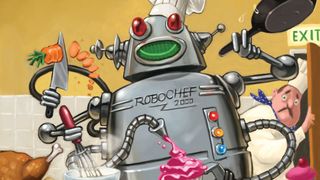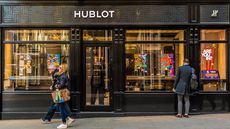Our new overlords? Meet the waiter, the doctor, the cleaner
Arnie’s killer cyborg said he’d “be back” – but he didn’t say what he’d be doing. Probably your dishes. Matthew Partridge looks at the best ways to invest in robots.


Arnie's killer cyborg said he'd "be back" but he didn't say what he'd be doing. Probably your dishes, says Matthew Partridge.
The word 'robot' was introduced to the English language in 1921 by Czech playwright Karel Capek. His play, R.U.R. (Rossum's Universal Robots), starts in a factory that manufactures robots, who go on to rebel and overthrow their human masters. It was a hit in its day, and ever since the theme of intelligent machines being created by, and ultimately supplanting, humanity, has never been far from our minds. From the Daleks of Doctor Who to the time-travelling killer cyborg in The Terminator, it seems we never tire of envisioning our own extinction at the hands of the monsters we've created.
The end of work?
Small wonder. Popular culture reflects the obsessions of society at large, and the relentless march of technology has always unsettled people. And right now, the rise of the robots is a potent source of fear for the future. The idea of a violent "robot rebellion" may remain well within the realms of fiction (for now at least). But it is clear that robots are becoming far more sophisticated and able to perform a much wider range of tasks, including those previously once considered too human for mere machines. That in turn has serious implications for the job market.
Subscribe to MoneyWeek
Subscribe to MoneyWeek today and get your first six magazine issues absolutely FREE

Sign up to Money Morning
Don't miss the latest investment and personal finances news, market analysis, plus money-saving tips with our free twice-daily newsletter
Don't miss the latest investment and personal finances news, market analysis, plus money-saving tips with our free twice-daily newsletter
Fears for jobs in the face of technological change is not new of course past "machine revolutions", including the mechanisation of agriculture and the industrial revolution, caused short-run disruption. But they also ended up creating new industries and transformed living standards.
However, there are growing concerns that this time is different that large numbers of people could be put out of work permanently. A recent study by Oxford University and Deloitte estimated that better machines and faster computers could eliminate more than a third of currently existing occupations in the next two decades. Another study by the Committee for Economic Development of Australia put the figure at 40%.
Of course, automation has plenty of potential positive aspects too. Some jobs are so unpleasant and dangerous that their demise or automation should be welcomed. And if the size of your potential workforce is declining anyway, then robots are the ideal solution. Japan's prime minister, Shinzo Abe, for example, has welcomed and actively promoted a "robotics revolution" as one way of solving problems created by Japan's unsustainable demographic picture.
Others argue that anything that boosts productivity is good for society we shouldn't try to prevent the robot revolution, but instead ensure that those who lose out are either compensated or find new opportunities. After all, the vision of vastly improved living standards leading to commensurately greater leisure time has been a long-held dream of utopian thinkers including John Maynard Keynes in his 1930 essay Economic Possibilities For Our Grandchildren.
You can't stop the robots
Whether automation's impact turns out to be positive or negative, the fact remains that it is taking place and probably more quickly than you realise. According to the International Federation of Robotics, an industry body, the number of industrial robots globally more than doubled from 70,000 in 2005 to nearly 180,000 by 2013. It is big business, with Transparency Market Research predicting that the market for such robots will grow by more than 6% a year from $29bn in 2013 to nearly $35bn by 2020.
As well as growing in absolute terms, the industry is becoming much more diversified. For now, the biggest user of robotics is the car industry. However, according to accountants PwC, the car industry has gone from accounting for 69% of all industrial robots in North America in 2005, to 56% in 2013. So while the car industry remains the major employer of robots, there are many other interesting growth areas. The most interesting for investors include food-related services, medicine and consumer robotics.
A less surly waiter
One part of the service sector that could be dramatically changed by automation is the food industry from the processing plants that provide the ingredients, to the restaurants where the finished dish is served to customers. All of these tasks rely on lots of routine mechanical steps the sorts of tasks at which robots excel. Indeed, the Oxford/Deloitte study puts all food service jobs at a high risk of being automated there's an 82% chance of human workers involved in food processing being rendered obsolete by robots, while waiters have a 90% risk of seeing their jobs vanish.
Until recently experts had believed that such jobs would remain safe because they require the worker to have sophisticated preparation skills or make several relatively sophisticated judgements about ripeness and quality of raw ingredients and so on. Yet now a Dutch company has developed a machine that uses a wide array of sensors to make such judgements. So far, it can expertly prepare a cabbage. The firm is working on other fruit and veg. Meanwhile, a San Francisco company is developing a robot that can automate all aspects of making a burger, from cooking the meat to adding the condiments.
Momentum Machines claims that its "Alpha" robot can produce up to 360 burgers an hour meaning the machine could pay for itself within two years if employed as a burger-flipper. Not only that, but it should improve the degree of consistency and the speed of service. Later versions are promised that will allow for demanding customers. The company's ultimate goal is to develop vending machines that deliver restaurant-quality food.
As for automated restaurant service, fast-food joints Burger King and McDonald's, as well as chains Applebee's and Chili's, are experimenting with in-store touch-screens that allow customers to order by machine. The UK-based Robot Pub Group (RPG) has taken the concept a step further customers not only order food via tablet computer, but also pour their own beer using special self-service machines. RPG now supplies machines to bars and pubs around the world.
So far though, Japanese sushi chain Kura has come closest to the idea of an entirely automated restaurant. Most food is prepared by machine and delivered by conveyor belt, with customers putting dirty dishes into a chute that leads to a dishwasher. Human managers are still needed to ensure nothing goes wrong, but they monitor processes by CCTV from a central command centre. It may seem extreme, but the idea (and the low prices) have proved highly popular: Kura now has 262 restaurants.
A more human GP
You would think doctors, who train for years in medical school and make difficult human judgements, would be safe from the robots. Yet they are already making inroads into direct patient care and the life sciences industries. Since 2000 more than two million procedures have been carried out by surgical machines. For now, most augment the skills of a human surgeon, who controls them via a computer. This allows procedures to be carried out with greater accuracy, which means incisions can be smaller, which in turn reduces potential side effects and recovery time, freeing up hospital beds and other resources.But the next step is fully autonomous robots that can carry out procedureswith little or no human assistance.
The surgeon's role would go from participant to supervisor, only stepping in on the rare occasions when things go wrong. Researchers at Berkeley (University of California) are working on automated surgical assistants. They have developed techniques that allow robots to "learn" to carry out routine tasks like suturing and knot tying to a far higher standard than humans.
Beyond the operating theatre, the hospital pharmacy is an area where automation could be even more helpful. The problem is that even the most skilled human pharmacy workers make errors, which can put lives at risk when you're handing out drugs. Frustrated at high error rates, one hospital in San Francisco has developed a system that automatically sorts medicines then uses another robot to transport them around the hospital to doctors. This has virtually eliminated errors, saved time and allowed pharmacy staff to spend more time with patients.
On the nursing front, Sumitomo Riko Company is working with RIKEN-SRK Collaboration Center for Human-Interactive Robot Research to develop "Robear" to move frail patients from bed to stretcher and back again, saving human staff from potential injuries, such as back problems. This robot with a bear's face is strong enough to transport most patients and move them to a standing position.
Run the vacuum over, Jeeves
The robotics revolution will really come home when we have machines doing the housework. So far, one of the best-known home robots is the Roomba. This robot vacuum cleaner was launched by iRobot in 2002 and newer models now detect which areas of a room need cleaning, while avoiding obstacles and stairs. iRobot has developed similar robots (Scooba and Braava) that can wash and mop hard floors.
More than 14 million units have been sold, and their success has not gone unnoticed, with rival brands including Dyson and Electrolux selling similar robots. Other robot "domestics" include iRobot's Looj (which will clean your gutters), Friendly Robotics' Robomow (which mows your lawn) and The Litter Robot from the same company (which will clean up after your pets).
Moley Robotics is now developing a robot chef that replicates the movements of a skilled chef (previously captured by sensors hooked up to said chef). Explicitly aimed at home users rather than restaurants, it is due to go on sale in 2018 at an initial price of $75,000 (£55,000), including appliances. Designer Mark Oleynik hopes to create a library of recipes produced by master chefs that can be implemented at the touch of a button, and even allow users to design their own.
As the population of most developed countries ages, devices that keep elderly people company will also become more common at home. Japanese mobile-phone firm SoftBank Mobile is about to release a robot called Pepper that can read body language and respond with appropriate facial expressions and engage in small talk. In response, rival firm NTT has said it will offer every elderly customer a robot named Sota that can do everything from talk to checking their blood pressure.
In short, robots are coming out of the factory and into our day-to-day lives we look at the companies best placed to profit below.
How to protect your job from the robots
Worried about becoming obsolete? You might get some tips on how to avoid beingreplaced by an automaton from an Oxford University study that came out earlier thisyear. It looked at nine traits for more than 700 job descriptions and worked out howeasily automated each job would be. The study reckons that more than a third ofexisting roles could go to robots within a decade or two.
To cut a long story short, ifyou want to keep the upper hand on the androids, you want to find a job that requirescreativity, that employs strong social skills and empathy, and requires being skilledin the arts of persuasion anything that involves understanding and dealing withyour fellow human beings, essentially. Jobs to avoid include those that are repetitive,predictable and routinised all characteristics that make a task easy to automate.
Ask your robo-broker to buy these now
Swiss conglomerate ABB Group (NYSE: ABB) focuses on automation, robotics and electrical equipment for power companies. While the automation and robotics units account for less than half of its sales, they provide most of the profits. The company has a strong foothold in the fast-growing food-processing robotics sector. This should help ABB maintain momentum in the mid-to-long term. The shares trade on 16.5 times earnings with a solid yield of more than 3%, making them less risky than many of the smaller stocks in the industry.
Japan's FANUC (JP: 6954) is the world's largest dedicated robotics company. While it mainly focuses on the vehicle industry, it also sells machines that automate elements of food processing. One of its most popular models is used to package food cheaply and quickly, cutting down on spoilage, saving firms money, and ensuring that the finished product can be promptly dispatched to supermarkets and retailers. It trades on a price/earnings (p/e) ratio of 18, and yields 2%.

Intuitive Surgical (Nasdaq: ISRG) makes robotic devices (marketed under the Da Vinci brand) that help surgeons by allowing them to manipulate tools precisely, rather than relying on their own dexterity. This reduces recovery times and the chance of complications, especially in operations such as prostate surgery. Surging demand, both in America and emerging markets such as India, and a dominant market position, mean Intuitive has been able to boost its profit margins, meaning its p/e falls from 32 to only 20 by 2017.
Renishaw (LSE: RSW) is a general engineering company. However, it has several offerings in the field of automation.The most interesting is Neuromate, a surgical robot that allows for greater precision when carrying out brain surgery, especially operations where electrodes are implanted in the brain (increasingly used to treat extreme epilepsy). It currently trades at 11 times current earnings, and yields 2%.
One of the best-known robotics firms is iRobot (Nasdaq: IRBT).A growing part of the company's revenue comes from the military and police, and it dominates the consumer robotics market via its range of vacuum cleaners and floor-washers. The company has announced plans to update existing models with new technology to fend off competition from rivalelectrical goods firms, and is developing a robotic lawn mower. This should help it to maintain strong double-digit sales growth. While its shares currently trade on a p/e of 25, this is set to fall to around 17 by 2016.As for funds, there are very few that focus specifically on robotics, rather than technology in general. One notable exception is the US-listed Robo-Stox ETF (Nasdaq: ROBO).
It was set up in 2013 and aims to track the sector through a wide range of holdings. While most of these focus on industrial robots, healthcare and consumer robots are also represented. The fund is also geographically diverse, with US firms accounting for only a third of holdings. Because of its monopoly it can charge a relatively high annual fee of 0.95%. However, it is still a useful vehicle for those who want broad-based exposure.
Matthew graduated from the University of Durham in 2004; he then gained an MSc, followed by a PhD at the London School of Economics.
He has previously written for a wide range of publications, including the Guardian and the Economist, and also helped to run a newsletter on terrorism. He has spent time at Lehman Brothers, Citigroup and the consultancy Lombard Street Research.
Matthew is the author of Superinvestors: Lessons from the greatest investors in history, published by Harriman House, which has been translated into several languages. His second book, Investing Explained: The Accessible Guide to Building an Investment Portfolio, is published by Kogan Page.
As senior writer, he writes the shares and politics & economics pages, as well as weekly Blowing It and Great Frauds in History columns He also writes a fortnightly reviews page and trading tips, as well as regular cover stories and multi-page investment focus features.
Follow Matthew on Twitter: @DrMatthewPartri
-
 Private school fees soar and VAT threat looms – what does it mean for you?
Private school fees soar and VAT threat looms – what does it mean for you?Rising private school fees could see more than one in five parents pull their children out of their current school. Before you remortgage, move house or look to grandparents for help, here’s what you need to know.
By Katie Williams Published
-
 Best and worst UK banks for online banking revealed
Best and worst UK banks for online banking revealedWhen it comes to keeping your money safe, not all banks are equal. We reveal the best and worst banks for online banking when it comes to protecting your money from scams
By Oojal Dhanjal Published
-
 Invest in space: the final frontier for investors
Invest in space: the final frontier for investorsCover Story Matthew Partridge takes a look at how to invest in space, and explores the top stocks to buy to build exposure to this rapidly expanding sector.
By Dr Matthew Partridge Published
-
 Invest in Brazil as the country gets set for growth
Invest in Brazil as the country gets set for growthCover Story It’s time to invest in Brazil as the economic powerhouse looks set to profit from the two key trends of the next 20 years: the global energy transition and population growth, says James McKeigue.
By James McKeigue Published
-
 5 of the world’s best stocks
5 of the world’s best stocksCover Story Here are five of the world’s best stocks according to Rupert Hargreaves. He believes all of these businesses have unique advantages that will help them grow.
By Rupert Hargreaves Published
-
 The best British tech stocks from a thriving sector
The best British tech stocks from a thriving sectorCover Story Move over, Silicon Valley. Over the past two decades the UK has become one of the main global hubs for tech start-ups. Matthew Partridge explains why, and highlights the most promising investments.
By Dr Matthew Partridge Published
-
 Could gold be the basis for a new global currency?
Could gold be the basis for a new global currency?Cover Story Gold has always been the most reliable form of money. Now collaboration between China and Russia could lead to a new gold-backed means of exchange – giving prices a big boost, says Dominic Frisby
By Dominic Frisby Published
-
 How to invest in videogames – a Great British success story
How to invest in videogames – a Great British success storyCover Story The pandemic gave the videogame sector a big boost, and that strong growth will endure. Bruce Packard provides an overview of the global outlook and assesses the four key UK-listed gaming firms.
By Bruce Packard Published
-
 How to invest in smart factories as the “fourth industrial revolution” arrives
How to invest in smart factories as the “fourth industrial revolution” arrivesCover Story Exciting new technologies and trends are coming together to change the face of manufacturing. Matthew Partridge looks at the companies that will drive the fourth industrial revolution.
By Dr Matthew Partridge Published
-
 Why now is a good time to buy diamond miners
Why now is a good time to buy diamond minersCover Story Demand for the gems is set to outstrip supply, making it a good time to buy miners, says David J. Stevenson.
By David J Stevenson Last updated